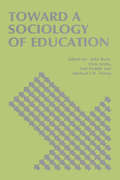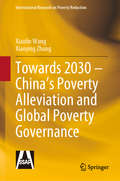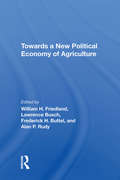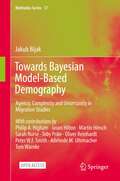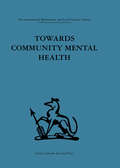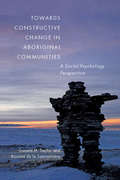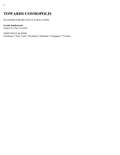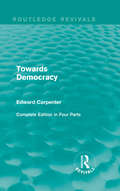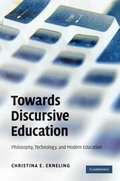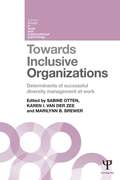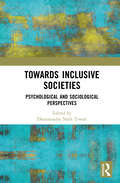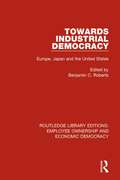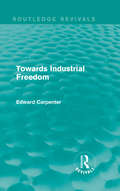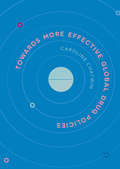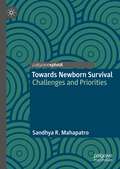- Table View
- List View
Toward a Sociology of Education
by John Beck, Chris Jenks, Nell Keddie and Michael F.D. YoungBy including material from literary, philosophical, and anthropological sources, and by selecting readings which consider educational practice both within and beyond formal educational contexts, this book broadens the character of sociological inquiry in education. The editors bring together material they have found valuable when working with students of education and sociology at all levels. Many of these articles and extracts are either inaccessible or have not been reprinted. The collection should stimulate inquiry about the assumptions underlying current debates on curriculum, streaming, school organization, methods of teachin, and preconceived notions of ability.
Toward a Unified Criminology: Integrating Assumptions about Crime, People and Society (New Perspectives in Crime, Deviance, and Law #1)
by Robert AgnewWhy do people commit crimes? How do we control crime? The theories that criminologists use to answer these questions are built on a number of underlying assumptions, including those about the nature of crime, free will, human nature, and society. These assumptions have a fundamental impact on criminology: they largely determine what criminologists study, the causes they examine, the control strategies they recommend, and how they test their theories and evaluate crime-control strategies. In Toward a Unified Criminology, noted criminologist Robert Agnew provides a critical examination of these assumptions, drawing on a range of research and perspectives to argue that these assumptions are too restrictive, unduly limiting the types of "crime" that are explored, the causes that are considered, and the methods of data collection and analysis that are employed. As such, they undermine our ability to explain and control crime. Agnew then proposes an alternative set of assumptions, drawing heavily on both mainstream and critical theories of criminology, with the goal of laying the foundation for a unified criminology that is better able to explain a broader range of crimes.
Toward an Architecture of Enjoyment
by Henri LefebvreToward an Architecture of Enjoyment is the first publication in any language of the only book devoted to architecture by Henri Lefebvre. Written in 1973 but only recently discovered in a private archive, this work extends Lefebvre&’s influential theory of urban space to the question of architecture. Taking the practices and perspective of habitation as his starting place, Lefebvre redefines architecture as a mode of imagination rather than a specialized process or a collection of monuments. He calls for an architecture of jouissance—of pleasure or enjoyment—centered on the body and its rhythms and based on the possibilities of the senses.Examining architectural examples from the Renaissance to the postwar period, Lefebvre investigates the bodily pleasures of moving in and around buildings and monuments, urban spaces, and gardens and landscapes. He argues that areas dedicated to enjoyment, sensuality, and desire are important sites for a society passing beyond industrial modernization. Lefebvre&’s theories on space and urbanization fundamentally reshaped the way we understand cities. Toward an Architecture of Enjoyment promises a similar impact on how we think about, and live within, architecture.
Toward an Integrated Science of Research on Families: Workshop Report
by Institute of Medicine National Research Council of the National AcademiesDemographic changes, immigration, economic upheavals, and changing societal mores are creating new and altered structures, processes, and relationships in American families today. As families undergo rapid change, family science is at the brink of a new and exciting integration across methods, disciplines, and epistemological perspectives. The purpose of The Science of Research on Families: A Workshop, held in Washington, DC, on July 13-14, 2010, was to examine the broad array of methodologies used to understand the impact of families on children's health and development. It sought to explore individual disciplinary contributions and the ways in which different methodologies and disciplinary perspectives could be combined in the study of families. Toward an Integrated Science of Research on Families documents the information presented in the workshop presentations and discussions. The report explores the idea of family research as being both basic and applied, offering opportunities for learning as well as intervention. It discusses research as being most useful when organized around particular problems, such as obesity or injury prevention. Toward an Integrated Science of Research on Families offers a problem-oriented approach that can guide a broad-based research program that extends across funders, institutions, and scientific disciplines.
Toward an Urban Cultural Studies
by Benjamin FraserToward an Urban Cultural Studies is a call for a new interdisciplinary area of research and teaching. Blending Urban Studies and Cultural Studies, this book grounds readers in the extensive theory of the prolific French philosopher Henri Lefebvre. Appropriate for both beginners and specialists, the first half of this book builds from a general introduction to Lefebvre and his methodological contribution toward a focus on the concept of urban alienation and his underexplored theory of the work of art. The second half merges Lefebvrian urban thought with literary studies, film studies and popular music studies, successively, before turning to the videogame and the digital humanities. Benjamin Fraser's approach consistently emphasizes the interrelationship between cities, culture, and capital.
Towards 2030 – China’s Poverty Alleviation and Global Poverty Governance (International Research on Poverty Reduction)
by Xiaolin Wang Xiaoying ZhangThis book assesses the global significance of China’s decade-long campaign to reduce poverty. After showing how the country’s unique approach to poverty alleviation brought about unparalleled progress toward achieving both the Millennium Development Goals (MDGs) and the Sustainable Development Goals (SDGs), the authors shed light on how China’s experience can help other countries around the globe as they try to permanently rid humanity of the scourge of poverty under ever more challenging social, economic and environmental conditions.
Towards A New Political Economy Of Agriculture
by William H FriedlandThe emergence of a truly global economy in the 1970s and the need to understand the subsequent changes in economic structure provided the impetus for this synthesis of the sociology of agriculture. The book offers the first formulations of a political economy theory that explains the transnational social and production relations of food and agriculture. Drawing upon studies of labour, technology, the state and gender, the contributors put forward a basis for reassessing and restating the intellectual framework of agriculture.
Towards AI-Aided Invention and Innovation: 23rd International TRIZ Future Conference, TFC 2023, Offenburg, Germany, September 12–14, 2023, Proceedings (IFIP Advances in Information and Communication Technology #682)
by Denis Cavallucci Stelian Brad Pavel LivotovThis book constitutes the proceedings of the 23rd International TRIZ Future Conference on Towards AI-Aided Invention and Innovation, TFC 2023, which was held in Offenburg, Germany, during September 12–14, 2023. The event was sponsored by IFIP WG 5.4.The 43 full papers presented in this book were carefully reviewed and selected from 80 submissions. The papers are divided into the following topical sections: AI and TRIZ; sustainable development; general vision of TRIZ; TRIZ impact in society; and TRIZ case studies.
Towards Africa's Renewal
by Jeggan C. SenghorAfrica still finds itself in the clutches of poverty and underdevelopment. The expected benefits from economic restructuring have not been realized and the debt burden continues to weigh heavily on African economies, constraining the possibilities of growth. Problems that have existed since the 1960s remain and links with the global economy continue to increase but fall short of requirements. Against this background it is not surprising that the vast majority of African states will not meet the Millennium Development Goals. The search for political systems that can deliver development have been categorized by cynics as old wine in old bottles with new stickers. As the dividends from globalization elude Africa in the 21st century, it becomes clear that it is a series of failed states, rogue states and even stateless states. This volume brings together leading researchers and analysts to examine issues and identify policy options which can lead to renewal in Africa. It provides an opportunity to reflect and offers a critical multidisciplinary appraisal of the future challenges facing Africa.
Towards Bayesian Model-Based Demography: Agency, Complexity and Uncertainty in Migration Studies (Methodos Series #17)
by Jakub BijakThis open access book presents a ground-breaking approach to developing micro-foundations for demography and migration studies. It offers a unique and novel methodology for creating empirically grounded agent-based models of international migration – one of the most uncertain population processes and a top-priority policy area. The book discusses in detail the process of building a simulation model of migration, based on a population of intelligent, cognitive agents, their networks and institutions, all interacting with one another. The proposed model-based approach integrates behavioural and social theory with formal modelling, by embedding the interdisciplinary modelling process within a wider inductive framework based on the Bayesian statistical reasoning. Principles of uncertainty quantification are used to devise innovative computer-based simulations, and to learn about modelling the simulated individuals and the way they make decisions. The identified knowledge gaps are subsequently filled with information from dedicated laboratory experiments on cognitive aspects of human decision-making under uncertainty. In this way, the models are built iteratively, from the bottom up, filling an important epistemological gap in migration studies, and social sciences more broadly.
Towards Community Mental Health
by John D SutherlandTavistock Press was established as a co-operative venture between the Tavistock Institute and Routledge & Kegan Paul (RKP) in the 1950s to produce a series of major contributions across the social sciences. This volume is part of a 2001 reissue of a selection of those important works which have since gone out of print, or are difficult to locate. Published by Routledge, 112 volumes in total are being brought together under the name The International Behavioural and Social Sciences Library: Classics from the Tavistock Press. Reproduced here in facsimile, this volume was originally published in 1971 and is available individually. The collection is also available in a number of themed mini-sets of between 5 and 13 volumes, or as a complete collection.
Towards Constructive Change in Aboriginal Communities
by Donald M. TaylorThe widespread failure of so many interventions in First Nations and Inuit communities across Canada requires an explanation. Applying the theoretical and methodological rigour of experimental social psychology to genuine community-based constructive change, Donald Taylor and Roxane de la Sablonnière outline new ways of addressing the challenges that Aboriginal leaders are vocalizing publicly. To date, the decolonization process in Canada has led to programs that focus on the struggling individual. However, colonization was and still is a collective process and thus requires collective solutions. Rooted in years of research, teaching, and experience in First Nations and Inuit communities, the authors offer necessary solutions. They contend that survey research can be uniquely applied as a means to initiate constructive community change, demonstrating how their intervention process uses such research to foster positive social norms by feeding the results back to the community. Ultimately, Towards Constructive Change in Aboriginal Communities outlines how field research can be used to give a voice to First Nations and Inuit community members and serve as a platform for constructive social change.
Towards Constructive Change in Aboriginal Communities: A Social Psychology Perspective
by Donald M. TaylorThe widespread failure of so many interventions in First Nations and Inuit communities across Canada requires an explanation. Applying the theoretical and methodological rigour of experimental social psychology to genuine community-based constructive change, Donald Taylor and Roxane de la Sablonnière outline new ways of addressing the challenges that Aboriginal leaders are vocalizing publicly. To date, the decolonization process in Canada has led to programs that focus on the struggling individual. However, colonization was and still is a collective process and thus requires collective solutions. Rooted in years of research, teaching, and experience in First Nations and Inuit communities, the authors offer necessary solutions. They contend that survey research can be uniquely applied as a means to initiate constructive community change, demonstrating how their intervention process uses such research to foster positive social norms by feeding the results back to the community. Ultimately, Towards Constructive Change in Aboriginal Communities outlines how field research can be used to give a voice to First Nations and Inuit community members and serve as a platform for constructive social change.
Towards Cosmopolis: Planning For Multicultural Cities
by Leonie SandercockFrom Polis to Metropolis, men and women have continued to struggle to perfect our cities. Urban history presents a picture of grand ideals and devastating failures. Towards Cosmopolis explores why we have failed, and how we could succeed, in building an urban Utopia - with a difference. Globalization, civil society, feminism and post-colonialism are the forces, ever shifting and changing our cities. We need a new vision to face such change. Sandercock pulls down the pillars of modernist city planning and raises in their place a new post-modern planning, a planning sensitive to community, environment and cultural diversity.
Towards Democracy (Routledge Revivals: The Collected Works of Edward Carpenter)
by Edward CarpenterEdward Carpenter’s Towards Democracy is well-known as a starting point of his later work. Originally written in 1881 whilst taking a break from lecturing in Universities across the UK, this four-volume poem dwells mainly on themes of freedom and equality; values that Carpenter wrote upon many times in his career. Originally published in 1883, this version in 1917, this title will be of interest to students of Sociology and English Literature.
Towards Discursive Education: Philosophy, Technology, and Modern Education
by Christina E. ErnelingAs technology continues to advance, the use of computers and the Internet in educational environments has immensely increased. But just how effective has their use been in enhancing children's learning? In this thought-provoking book, Christina E. Erneling conducts a thorough investigation of scholarly journal articles on how computers and the Internet affect learning. She critiques the influential pedagogical theories informing the use of computers in schools - in particular those of Jean Piaget and 'theory of mind' psychology. Erneling introduces and argues for a discursive approach to learning based on the philosophy of Ludwig Wittgenstein and the psychology of Lev Vygotsky. This book not only addresses an urgent pedagogical problem in depth, but also challenges dominant assumptions about learning in both developmental psychology and cognitive science.
Towards Equity in Mathematics Education
by Helen Forgasz Ferdinand RiveraThis volume gathers together twenty major chapters that tackle a variety of issues associated with equity in mathematics education along the dimensions of gender, culture, curriculum diversity, and matters of a biological nature. The pursuit of equity in mathematics education is an important concern in the history of the present. Since there is no doubt about the significant role of mathematics in almost every aspect of life, it means that all individuals regardless of sex, in any age range, and in whatever context need to be provided with an opportunity to become mathematically able. The publication of this Springer volume on equity in mathematics education is situated at a time when there is strong and sustained research evidence indicating the persistence of an equity gap in mathematics, which has now enabled the mathematics education community to engage in a discourse of access for all. The research studies that are reported and discussed in the volume have been drawn from an international group of distinguished scholars whose impressive, forward-looking, and thought-provoking perspectives on relevant issues incite, broaden, and expand complicated conversations on how we might effectively achieve equity in mathematics education at the local, institutional, and systemic levels. Further, the up-to-date research knowledge in the field that is reflected in this volume provides conceptual and practical outlines for mechanisms of change, including models, examples, and usable theories that can inform the development of powerful equitable practices and the mobilization of meaningful equity interventions in different contexts of mathematics education.
Towards Healthy Settlements: Health Implications of Residential Suburbanization in Guangzhou (Urban Sustainability)
by Tianyao ZhangThis book aims to formulate recommendations for achieving a healthy neighborhood living environment for the middle-income people in China‘s suburbs. In China, the expeditious urbanization triggers the prosperous commodity housing development, which further grows with the spatial restructuring and socioeconomic transition. Residential suburbanization is generated, accompanied with the emergence of new-middle class and the change of lifestyle. However, the health effects of suburbanization in China are overlooked. This book investigates the health performance of suburban residents and the effects of suburban living on residents‘ health. This book also examines the resident-environment transaction modes to unfold the underlying mechanism of suburban living affecting residents’ health. Suburban residents had to passively adapt to their residential environment, which is the obstacle for achieving a health-promoting environment. The institutional dynamics determining the health performance of suburban living environment were addressed with the roles of governments, developers, planners, housing managers, residents‘ committee, and ordinary residents in commodity housing development. The book found no institutional support for the creation of health-promoting environments, especially with default of governments and excessive dependence on developers for public service facilities and the absence of civil society. Thus, the book proposes that institutional innovations are necessary in term of embedding the health dimension in all sectors of the society, enlisting collaboration between public and private sectors, and between health and non-health sectors, and thus cultivating the optimization of residents-environment transactions to create health-promoting environments.
Towards Inclusive Organizations: Determinants of successful diversity management at work
by Karen van der Zee Marilynn B. Brewer Sabine OttenDiversity arising from the mixing of peoples from different cultural backgrounds has long been an issue in nations such as the United States and Australia, and in recent decades, European nations have reached unprecedented levels of cultural diversity due to increased migration. This phenomenon of increasing cultural diversity at the national level sets the context for current social science research on the consequences of diversity for social integration, institutional functioning, and interpersonal relationships. This book reviews theory and research in social and organizational psychology on the management of diversity in work organizations. The book shows how diversity management takes place across multiple levels: at a national level, at an organizational level, between work groups and teams, in interpersonal relations, and at the level of individual experiences. Each chapter summarizes relevant empirical research, and considers how the dynamics of workgroup relations are likely to be affected by cultural differences among group members. The contributors also describe the variables which organizational leadership should be sensitive to in designing and implementing policies and practices for inclusive organizations. Towards Inclusive Organizations will be essential reading for researchers and advanced students in social and organizational psychology.
Towards Inclusive Societies: Psychological and Sociological Perspectives
by Dharmendra Nath TiwariTowards Inclusive Societies: Psychological and Sociological Perspectives focuses on the importance of building inclusive societies and communities for global human welfare within psychological, social, political, and cultural realms. It discusses the engagement of psychology and other social science disciplines on the need for building both cultural sensitivity and interdisciplinary dialogue. The volume presents the issues and consequences of globalization and diversity in the social and psychological domains and their role in shaping the physical and mental health of people. It systematically examines the various parameters of inclusivity such as equality, equity, social identity, social stigma, and coexistence of differences in socio-cultural behaviour. The volume focuses on the developments towards building inclusive societies in the South Asian countries including, India, Bangladesh, and Nepal. It also highlights the challenges and possibilities in making social-psychological discourses more inclusive. This book will be of interest to students, teachers, and scholars of psychology, cultural psychology, gender psychology, social psychology, sociology, and political science and social work. It will also be useful for psychologists, sociologists, social scientists, social workers, political scientists, and Gandhian philosophers.
Towards Industrial Democracy: Europe, Japan and the United States (Routledge Library Editions: Employee Ownership and Economic Democracy #10)
by Benjamin C. RobertsThis study, first published in 1979, analysed the international trend towards "industrial democracy" in the industrial relations practices in Europe, Japan and the United States. The development of industrial democracy was occurring through the establishment of employee and union participation on boards of directors and, at the shop floor level, in the extension of the role and power of works councils. In other countries the main development was through collective bargaining methods on labor-management relations and management decision-making. The authors examine various countries and explore any highlights, lessons and ideas that might be transferable from one political and social context to another.
Towards Industrial Freedom (Routledge Revivals: The Collected Works of Edward Carpenter)
by Edward CarpenterOriginally published in 1917 in the midst of World War I, Carpenter argues that industry in pre-war Britain was simply exploitation of labour for private gain and attempts to look toward a future with more socialist values. The papers in this study explore the negative aspects of industrial life and suggest a new outlook with which the United Kingdom can move forward in industry. This title will be of interest to students of sociology.
Towards More Effective Global Drug Policies
by Caroline ChatwinThis book examines the topical issue of global drug policy and outlines five steps that could be taken to improve its effectiveness. A public criminology approach is applied to explore not only what could be done, but also why it matters and how it could be achieved. It argues that more effective global drug policies require an acknowledgement of the failure of a war on drugs approach and the harms it has caused. Instead, strategies that reduce drug related harm should be prioritised. An innovative and diverse range of approaches should be developed that are underpinned by evaluation and dissemination of results. Finally, the horizons of the drug policy debate should be broadened. In line with the central aims of public criminology, this book provides an accessible contribution to global drug policy debates that links theory and practice and which will have appeal to a wide range of audiences.
Towards Newborn Survival: Challenges and Priorities
by Sandhya R. MahapatroThis book offers a comprehensive study of the complexities of newborn survival in resource-poor regions, using the state of Bihar (India) as a case study. It provides important lessons for other low-performing countries, in similar socioeconomic contexts, where newborn survival is a major challenge.The volume opens with a brief account of the trends and regional variations in neonatal mortality. The empirical verification of socio-cultural, economic and health system barriers and the state interventions that affect newborn survival are subsequently explored. Innovative strategies are then proposed to scale up maternal newborn and child health (MNCH) services and improve neonatal health outcomes. Addressing this issue through appropriate policy action is essential to achieving Sustainable Development Goal-3, "Good Health and Well-being". This book will therefore appeal to public health scholars, professionals and policymakers interested in improving outcomes in low-income regions.
Towards Open and Trustworthy Digital Societies: 23rd International Conference on Asia-Pacific Digital Libraries, ICADL 2021, Virtual Event, December 1–3, 2021, Proceedings (Lecture Notes in Computer Science #13133)
by Hao-Ren Ke Chei Sian Lee Kazunari SugiyamaThis book constitutes the refereed proceedings of the 23rd International Conference on Asia-Pacific Digital Libraries, ICADL 2021, which was held in December 2021. Due to COVID-19 pandemic the conference was held virtually.The 17 full, 14 short, and 5 practice papers presented in this volume were carefully reviewed and selected from 87 submissions. The papers were organized in topical sections named: Knowledge Discovery from Digital Collections; Search for Better User Experience; Information Extraction; Multimedia; Text Classification and Matching; Data Infrastructure for Digital Libraries; Data Modeling; Neural-based Learning.
